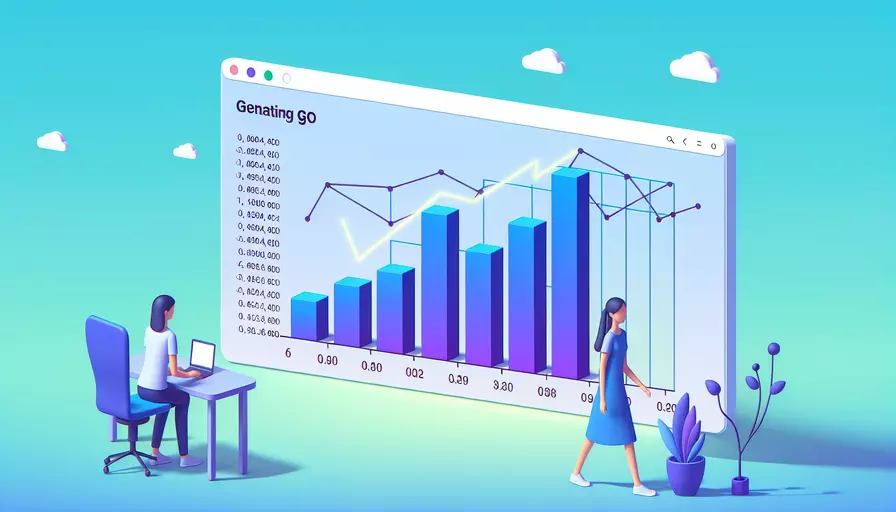
在Go语言中输出图片,可以通过以下几个步骤来实现:1、使用相关库进行图片处理;2、生成图片文件;3、输出图片数据。以下是详细步骤和说明:
Go语言提供了丰富的库来处理图片数据,其中最常用的是标准库中的image、image/color、image/draw以及image/jpeg、image/png等。我们可以利用这些库来创建、修改和输出图片。
一、使用相关库进行图片处理
首先,需要导入相关的Go标准库,这些库提供了处理和生成图片所需的功能:
import (
"image"
"image/color"
"image/draw"
"image/jpeg"
"image/png"
"os"
)
这些库各自有不同的作用:image提供了基本的图片接口和类型,image/color定义了颜色类型,image/draw用于绘制图片,image/jpeg和image/png则用于编码和解码JPEG和PNG格式的图片。
二、生成图片文件
接下来,我们可以生成图片文件。以下是一个简单的示例,创建一个100×100的PNG图片,并在图片中绘制一个红色的矩形:
func createImage() {
// 创建一个RGBA图像
img := image.NewRGBA(image.Rect(0, 0, 100, 100))
// 设置一个红色矩形
red := color.RGBA{255, 0, 0, 255}
for x := 0; x < 100; x++ {
for y := 0; y < 100; y++ {
if x > 20 && x < 80 && y > 20 && y < 80 {
img.Set(x, y, red)
}
}
}
// 创建一个文件
file, err := os.Create("image.png")
if err != nil {
panic(err)
}
defer file.Close()
// 使用PNG编码器将图像写入文件
err = png.Encode(file, img)
if err != nil {
panic(err)
}
}
这个示例代码创建了一个100×100的RGBA图像,并在图像中绘制了一个红色的矩形,然后使用PNG编码器将图像保存到一个文件中。
三、输出图片数据
为了在HTTP服务器中输出图片数据,我们可以使用标准库中的net/http包。以下是一个简单的HTTP服务器示例,它将图片数据返回给客户端:
package main
import (
"image"
"image/color"
"image/png"
"net/http"
)
func imageHandler(w http.ResponseWriter, r *http.Request) {
// 创建一个RGBA图像
img := image.NewRGBA(image.Rect(0, 0, 100, 100))
// 设置一个红色矩形
red := color.RGBA{255, 0, 0, 255}
for x := 0; x < 100; x++ {
for y := 0; y < 100; y++ {
if x > 20 && x < 80 && y > 20 && y < 80 {
img.Set(x, y, red)
}
}
}
// 设置HTTP响应头
w.Header().Set("Content-Type", "image/png")
// 使用PNG编码器将图像写入HTTP响应
err := png.Encode(w, img)
if err != nil {
http.Error(w, err.Error(), http.StatusInternalServerError)
}
}
func main() {
http.HandleFunc("/image", imageHandler)
http.ListenAndServe(":8080", nil)
}
这个HTTP服务器在端口8080上监听,并处理/image路径的请求。每当有请求到达时,它会生成一个100×100的PNG图片,并将图片数据返回给客户端。
四、使用JPEG格式输出图片
有时我们可能需要使用JPEG格式输出图片。以下是一个示例,演示如何生成并输出JPEG图片:
package main
import (
"image"
"image/color"
"image/jpeg"
"net/http"
)
func imageHandler(w http.ResponseWriter, r *http.Request) {
// 创建一个RGBA图像
img := image.NewRGBA(image.Rect(0, 0, 100, 100))
// 设置一个蓝色矩形
blue := color.RGBA{0, 0, 255, 255}
for x := 0; x < 100; x++ {
for y := 0; y < 100; y++ {
if x > 20 && x < 80 && y > 20 && y < 80 {
img.Set(x, y, blue)
}
}
}
// 设置HTTP响应头
w.Header().Set("Content-Type", "image/jpeg")
// 使用JPEG编码器将图像写入HTTP响应
err := jpeg.Encode(w, img, nil)
if err != nil {
http.Error(w, err.Error(), http.StatusInternalServerError)
}
}
func main() {
http.HandleFunc("/image", imageHandler)
http.ListenAndServe(":8080", nil)
}
这个示例与之前的PNG示例类似,但使用了jpeg.Encode函数将图像编码为JPEG格式,并将其输出到HTTP响应中。
五、动态生成和输出图片
有时候,我们需要根据用户的输入或其他动态数据生成图片并输出。以下是一个示例,演示如何根据URL参数动态生成图片:
package main
import (
"image"
"image/color"
"image/png"
"net/http"
"strconv"
)
func imageHandler(w http.ResponseWriter, r *http.Request) {
// 从URL参数获取图像尺寸
width, err := strconv.Atoi(r.URL.Query().Get("width"))
if err != nil || width <= 0 {
width = 100
}
height, err := strconv.Atoi(r.URL.Query().Get("height"))
if err != nil || height <= 0 {
height = 100
}
// 创建一个RGBA图像
img := image.NewRGBA(image.Rect(0, 0, width, height))
// 设置一个绿色矩形
green := color.RGBA{0, 255, 0, 255}
for x := 0; x < width; x++ {
for y := 0; y < height; y++ {
if x > width/4 && x < 3*width/4 && y > height/4 && y < 3*height/4 {
img.Set(x, y, green)
}
}
}
// 设置HTTP响应头
w.Header().Set("Content-Type", "image/png")
// 使用PNG编码器将图像写入HTTP响应
err = png.Encode(w, img)
if err != nil {
http.Error(w, err.Error(), http.StatusInternalServerError)
}
}
func main() {
http.HandleFunc("/image", imageHandler)
http.ListenAndServe(":8080", nil)
}
这个示例根据URL参数width和height动态生成图片。例如,访问http://localhost:8080/image?width=200&height=200将生成一个200×200的PNG图片。
六、图片处理和修改
除了生成静态图片,Go语言还支持对现有图片进行处理和修改。以下是一个示例,演示如何加载、修改并输出图片:
package main
import (
"image"
"image/color"
"image/draw"
"image/jpeg"
"net/http"
"os"
)
func imageHandler(w http.ResponseWriter, r *http.Request) {
// 打开现有图片文件
file, err := os.Open("example.jpg")
if err != nil {
http.Error(w, err.Error(), http.StatusInternalServerError)
return
}
defer file.Close()
// 解码JPEG图像
img, err := jpeg.Decode(file)
if err != nil {
http.Error(w, err.Error(), http.StatusInternalServerError)
return
}
// 创建一个新的RGBA图像
rgba := image.NewRGBA(img.Bounds())
// 将解码的图像绘制到新的RGBA图像
draw.Draw(rgba, rgba.Bounds(), img, image.Point{}, draw.Over)
// 在图像上绘制一个黄色矩形
yellow := color.RGBA{255, 255, 0, 255}
for x := 20; x < 80; x++ {
for y := 20; y < 80; y++ {
rgba.Set(x, y, yellow)
}
}
// 设置HTTP响应头
w.Header().Set("Content-Type", "image/jpeg")
// 使用JPEG编码器将图像写入HTTP响应
err = jpeg.Encode(w, rgba, nil)
if err != nil {
http.Error(w, err.Error(), http.StatusInternalServerError)
}
}
func main() {
http.HandleFunc("/image", imageHandler)
http.ListenAndServe(":8080", nil)
}
这个示例加载一个名为example.jpg的JPEG图片,并在其上绘制一个黄色矩形,然后将修改后的图片输出到HTTP响应中。
七、总结和建议
通过以上示例,我们可以看到,Go语言提供了丰富的工具和库来生成、处理和输出图片。使用这些工具,我们可以轻松地根据需求生成静态或动态图片,并在HTTP服务器中输出图片数据。
总结主要观点:
- 使用标准库生成和处理图片:Go语言的标准库提供了强大的功能来生成和处理图片。
- 输出图片数据:通过HTTP服务器,可以将生成的图片数据返回给客户端。
- 支持多种图片格式:Go语言支持多种图片格式的编码和解码,如PNG和JPEG。
- 动态生成图片:可以根据用户输入或其他动态数据生成图片。
进一步的建议或行动步骤:
- 学习和掌握Go标准库的使用:深入学习
image、image/color、image/draw等库的使用,掌握更多图片处理技巧。 - 扩展图片处理功能:结合其他图像处理库,如
github.com/nfnt/resize,实现更复杂的图像处理功能。 - 优化性能:在处理大规模图片或高并发请求时,关注性能优化,确保服务器的稳定性和响应速度。
- 安全性考虑:处理用户上传的图片时,注意安全性,防止恶意输入导致服务器崩溃或数据泄露。
相关问答FAQs:
1. Go语言如何输出图片到文件?
在Go语言中,我们可以使用image和image/png包来输出图片到文件。下面是一个简单的示例:
package main
import (
"image"
"image/color"
"image/png"
"os"
)
func main() {
// 创建一个新的RGBA图片
img := image.NewRGBA(image.Rect(0, 0, 200, 200))
// 在图片上绘制一些内容
for x := 0; x < img.Bounds().Dx(); x++ {
for y := 0; y < img.Bounds().Dy(); y++ {
img.Set(x, y, color.RGBA{uint8(x), uint8(y), 255, 255})
}
}
// 创建一个输出文件
file, err := os.Create("output.png")
if err != nil {
panic(err)
}
defer file.Close()
// 将图片写入文件
err = png.Encode(file, img)
if err != nil {
panic(err)
}
println("图片已输出到文件 output.png")
}
运行以上代码,会在当前目录下生成一个名为output.png的图片文件,该图片是一个200×200像素的渐变图片。
2. 如何在Go语言中将图片输出到HTTP响应?
在Go语言中,我们可以使用http包来将图片输出到HTTP响应。下面是一个示例:
package main
import (
"image"
"image/color"
"image/png"
"net/http"
)
func handler(w http.ResponseWriter, r *http.Request) {
// 创建一个新的RGBA图片
img := image.NewRGBA(image.Rect(0, 0, 200, 200))
// 在图片上绘制一些内容
for x := 0; x < img.Bounds().Dx(); x++ {
for y := 0; y < img.Bounds().Dy(); y++ {
img.Set(x, y, color.RGBA{uint8(x), uint8(y), 255, 255})
}
}
// 将图片写入HTTP响应
w.Header().Set("Content-Type", "image/png")
err := png.Encode(w, img)
if err != nil {
http.Error(w, err.Error(), http.StatusInternalServerError)
return
}
}
func main() {
http.HandleFunc("/", handler)
http.ListenAndServe(":8080", nil)
}
运行以上代码,然后在浏览器中访问http://localhost:8080,就会看到一个渐变图片。
3. 如何在Go语言中将图片输出到终端?
在Go语言中,我们可以使用fmt和image包来将图片输出到终端。下面是一个示例:
package main
import (
"fmt"
"image"
"image/color"
)
func main() {
// 创建一个新的RGBA图片
img := image.NewRGBA(image.Rect(0, 0, 20, 10))
// 在图片上绘制一些内容
for x := 0; x < img.Bounds().Dx(); x++ {
for y := 0; y < img.Bounds().Dy(); y++ {
img.Set(x, y, color.RGBA{uint8(x), uint8(y), 255, 255})
}
}
// 将图片输出到终端
for y := 0; y < img.Bounds().Dy(); y++ {
for x := 0; x < img.Bounds().Dx(); x++ {
c := img.At(x, y)
r, g, b, _ := c.RGBA()
fmt.Printf("\x1b[48;2;%d;%d;%dm ", r>>8, g>>8, b>>8)
}
fmt.Println("\x1b[0m")
}
}
运行以上代码,会在终端输出一个渐变图片。请注意,这种方法只适用于支持TrueColor的终端。
文章标题:go语言怎么输出图片,发布者:不及物动词,转载请注明出处:https://worktile.com/kb/p/3501974

 微信扫一扫
微信扫一扫  支付宝扫一扫
支付宝扫一扫 